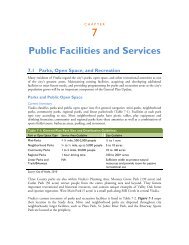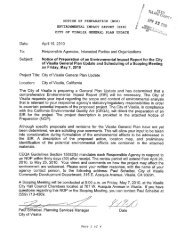General Plan Update Review Committee Draft Elements Part 2 For ...
General Plan Update Review Committee Draft Elements Part 2 For ...
General Plan Update Review Committee Draft Elements Part 2 For ...
You also want an ePaper? Increase the reach of your titles
YUMPU automatically turns print PDFs into web optimized ePapers that Google loves.
To protect farm land and open space, the Land Use<br />
Element establishes a fairly compact urban area. The<br />
total future urbanized area under the <strong>General</strong> <strong>Plan</strong><br />
is slightly smaller than under the previous <strong>Plan</strong> while<br />
accommodating population growth to 2030.<br />
6-14 VISALIA GENERAL PLAN UPDATE<br />
Table 6-1: Farmland Classification in the Study Area<br />
Type<br />
Existing<br />
Acres<br />
Soils<br />
The <strong>Plan</strong>ning Area is in a basin bounded by the Sierra<br />
Nevada foothills and mountains to the east and the<br />
Coast Ranges to the west, and filled with deep layers<br />
of sediment from the Sierra Nevada. The St. Johns<br />
River flows through the northeastern portion of the<br />
planning area, along with smaller streams and canals;<br />
these form alluvial fans. The area is basically flat,<br />
lying at an elevation of 330 feet or so above sea level.<br />
Surface soils exhibit various characteristics dependent<br />
on location, slope, parent rock, climate, and<br />
drainage. The most prevalent soils in the <strong>Plan</strong>ning<br />
Area are Nord fine sandy loam (19,200 acres); Grangeville<br />
sandy loam, drained (15,700 acres); Tagus loam<br />
(12,500 acres); and Akers-Akers, saline-sodic, complex<br />
(8,100 acres). These are generally very deep, well<br />
drained soils formed in alluvium derived from granitic<br />
rock sources, with slopes of 0 to 2 percent.<br />
Conservation efforts are continually being made to<br />
prevent soil erosion and the chemical alteration of soils<br />
Percent of<br />
Study Area<br />
Acres at <strong>General</strong><br />
<strong>Plan</strong> Buildout<br />
Percent of<br />
Study Area Change<br />
Prime Farmland 33,991 51% 21,501 32% 12,490<br />
Farmland of Statewide Importance 7,353 11% 6,954 10% 399<br />
Unique Farmland 181 0% 137 0% 44<br />
Farmland of Local Importance 1,630 2% 298 0% 1,333<br />
Confined Animal Agriculture 1,218 2% 908 1% 310<br />
TOTAL FARMLAND 44,374 67% 29,798 45% 14,576<br />
STUDY AREA 66,644 100% 66,644 100% 0<br />
Sources: Department of Conservation, Division of Land Resource Protection, 2012; Dyett & Bhatia, 2012.<br />
caused by overuse, salinization, acidification, or other<br />
chemical soil contamination. Maintaining soil quality<br />
is important to sustain plant and animal productivity,<br />
maintain or enhance water and air quality, and support<br />
human health and habitation. While State and<br />
federal laws regulate soil quality, as indicated by the<br />
farmland classification system, local land use planning<br />
is important for limiting erosion potential.<br />
Erosion Potential<br />
Erosion is the process by which the soil and rock<br />
components of the earth’s crust are worn away and<br />
removed from one place to another by natural forces<br />
such as weathering, solution, and transportation. Soil<br />
erosion can lead to sedimentation of watercourses,<br />
eventually having an adverse impact on water quality<br />
and aquatic life. Furthermore, once erosion occurs, it<br />
may be difficult for natural vegetation to reestablish<br />
itself. The loss of topsoil to erosion is detrimental to<br />
agriculture and other landscaping. The risk of erosion<br />
is greatly increased during grading and construction




